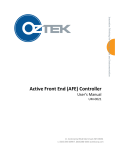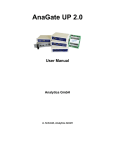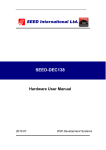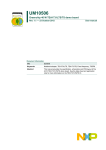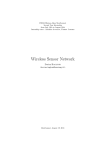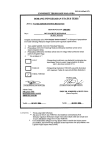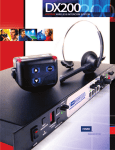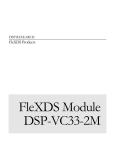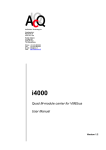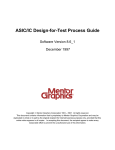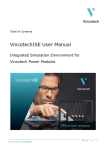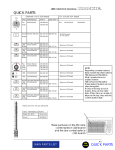Download User`s Manual
Transcript
DSP2 User’s Manual Copyright © 2001 University of Maribor Faculty of Electrical Engineering and Computer Science Institute of Robotics Smetanova ulica 17 2000 MARIBOR SLOVENIA http://www.ro.feri.uni-mb.si/Welcome.html-l2 Manual version: Firmware version: PCB version: Bios version: Terminal version: V 0.704.17 V0.80 V1.00 V1.10 V1.1a (March 13, 2001) (April 17, 2000) (Februar 12, 2000) (Mai 12, 2000) (Jan 23, 2000) Contents Contents 1. DSP board overview ___________________________________________________ 1 2. Simplified Function Diagram ____________________________________________ 2 3. DSP2 Memory Map ____________________________________________________ 3 4. Interrupts ____________________________________________________________ 4 5. FPGA Registers Reference ______________________________________________ 5 5.1 AD Unit _________________________________________________________ 5.1.1 AD Operation _________________________________________________ Register ADCTRL (address 0x900002 - WRITE) ___________________________ Register AD0 (address 0x900001 - READ) ________________________________ Registers AD1 (address 0x900002), AD2 (address 0x900003), AD3 (address 0x900004)__________________________________________________________ Registers AD1 (address 0x900002), AD2 (address 0x900003), AD3 (address 0x900004)__________________________________________________________ ii 5 5 6 6 7 7 2 5.2 I C EEPROM____________________________________________________ 8 Register W_I2C (address 0x90000E) ____________________________________ 8 Register R_I2C (address 0x90000E)____________________________________ 8 5.3 Asynchronous Serial Communications Interface _______________________ 9 Receiver Status Register RS_STAT (address 0x900006) _____________________ 9 Serial Control Register CRTL (address 0x900004) _________________________ 9 Serial Receive Register RX0 (address 0x900005) _________________________ 10 Serial Transmit Register TX0 (address 0x900003) _________________________ 10 5.4 Three Phase Pulse Width Modulator ________________________________ Modulator Period Register W_MOD_PER (address 0x900005) _______________ Modulator Dead Time Set Register W_MOD_TM (address 0x900009) _________ Modulator Phase 1 Pulse Width Register W_MOD_T1 (address 0x900006) _____ Modulator Phase 2 Pulse Width Register W_MOD_T2 (address 0x900007) _____ Modulator Phase 3 Pulse Width Register W_MOD_T3 (address 0x900008) _____ Modulator Status Register W_MOD_STAT (address 0x90000F) ______________ 5.5 FLASH PROM Interface__________________________________________ 13 Flash PROM Register W_FLASH (address 0x90000F) _____________________ 13 5.6 Analog Output Unit ______________________________________________ Analog Output 0 Register DA0 (address 0x900000) ________________________ Analog Output 1 Register DA1 (address 0x900001) ________________________ Analog Output Status Register DASTAT (address 0x900000) ________________ 5.7 Incremental Encoder Interface _____________________________________ 14 Incremental Encoder Position Read Register R_INC_POS (address 0x900007) __ 14 Incremental Encoder Time Read Register R_INC_TIME (address 0x900008)____ 15 5.8 Extension IO pins on FPGA _______________________________________ 15 Flash PROM Register W_FLASH (address 0x90000F) _____________________ 15 5.9 CAN Interface___________________________________________________ Write CAN Register W_CAN (address 0x900800F) ________________________ Read CAN Register R_CAN (address 0x900800F) _________________________ CAN Control Register W_CAN CTRL (address 0x9000A) __________________ 11 11 11 12 12 12 12 13 13 14 14 16 16 16 16 Contents CAN Status Register W_CAN STAT (address 0x900009) ___________________ 16 6. Connectors and Jumpers Locations ______________________________________ 17 6.1 P1 – IGBT Bridge Analogue inputs __________________________________ 17 6.2 P3 Serial communication (RS232) ___________________________________ 17 6.3 P4 Incremental encoder input ______________________________________ 17 6.4 P5 IGBT Bridge – digital I/O _______________________________________ 18 6.5 J1 Analogue outputs, analogue inputs________________________________ 18 6.6 J2 DSP serial communication_______________________________________ 19 6.7 J3 Jumpers for DSP Boot mode select________________________________ 19 6.6 J4 MPSD – emulator interface______________________________________ 19 6.8 J5 DSP Watch dog enable__________________________________________ 19 6.9 J6 Serial interface RS485 __________________________________________ 19 6.10 J7 EEPROM write enable _________________________________________ 20 6.11 J8 optically isolated (three inputs and one output) _____________________ 20 6.12 J9 CAN interface (before and after line driver), 16 I/O user defined pins __ 20 6.13 J10 FPGA extension pins __________________________________________ 20 6.14 J11 FPGA JTAG interface _________________________________________ 21 6.15 J12 FPGA external programming interface ___________________________ 21 6.16 J13 two DSP timer outputs_________________________________________ 21 6.17 Power supply ____________________________________________________ 21 7. Fast analog inputs modifications_________________________________________ 23 8. References___________________________________________________________ 25 Tables Table 1: DSP2 Memory Map ....................................................................................................3 Table 2: FPGA Register Map....................................................................................................5 Table 3: AD3 Input selection table ...........................................................................................6 Table 4: DSP2 Power supply connections ..............................................................................21 Table 5: Power supply signals explanation .............................................................................22 Table 6: Normal (current) fast analogue input configuration .................................................23 Table 7: Modified fast analogue input configuration for use with MiniSKiiP IGBT module 23 Figures Figure 1: DSP2 Function Diagram............................................................................................2 Figure 2: Analog Input Configuration.......................................................................................5 Figure 3: I2C Implementation Detail ........................................................................................8 Figure 4: Asynchronous Serial Communications Baud Rate Select .........................................9 Figure 5: Connector with Test Pins on DSP2 Board Detail ....................................................16 Figure 6: Connectors and Jumpers Locations .........................................................................17 Figure 7: Power Fail Input Detail............................................................................................18 iii DSP board overview 1. DSP board overview The DSP-2 board is a high performance, floating point digital signal processor (DSP) based inverter controller designed primarily to control a three-phase AC motor. The board is based on Texas Instruments TMS320C32 DSP and Field Programmable Gate Array (FPGA) XCS40-4PQ240C member of Xilinx Spartan Family. • DSP TMS320C32-60MHz o DSP serial interface o Two timer general purpose io pins o DSP MPSD interface for XDS510 emulator • FLASH 256K x 8 - 70ns • SRAM 128K x 32 0WS • 4 channel simultaneous 12bit A/D with serial output o Conversion and transfer to register in FPGA 2,6µs for all four channels o One channel has unipolar input range 0 to 4.095V or 0 to 40,95mA with 100OHM shunt resistor (udc) o Two have bipolar input range –2.096 to 4.094V or -40,96mA to 40.94mA with 100OHM shunt resistor o One channel has input multiplexer to select one of eight voltage input signals o First order input RC filters (time constant 33µs for i1 and i3 and 100µs for udc) • Two channel 12bit D/A converter with serial input and unipolar output 0 to 4V • RS232 full duplex interface with fixed Baud Rate (38400kBd 8bits ,1stop ,No parity) • RS485 interface (not implemented in this firmware version (April 17, 2000) • RS422 receiver for incremental encoder • Three logic inputs and one output – all optically isolated (12V passive) • Bridge protection circuit o Interlock between bottom and top IGBT activation and dead time o Minimum pulse width, minimum pause width o In the presence of fault signal the bridge is shut down unconditionally • Three phase synchronous pulse width modulator o Twelve bit up/down counter for triangle generation o Symmetrical output pulses o 66.6ns time resolution o can generate interrupt pulses ones or twice in one modulator period • Incremental encoder speed measurement with improved MT method o 66.6ns time resolution o Position register contain position increment during sampling period o Time register contain relative time (in one modulator period) of last position change o Booth registers are saved on interrupt and are available until next interrupt • Stand alone operation. Program is preloaded in FLASH. • Operation with personal computer o Code Composer software development environment o Standard RS232 serial interface (38400Bd) and Terminal software o MPSD interface for XDS510 emulator o Multipoint communications RS485 and CAN (not implemented yet) • Board dimensions 161 x 130 mm 1 Simplified Function Diagram 2. Simplified Function Diagram Power supply supervisor 32 DSP TMS320C32-60 EEPROM 4...256kb ADM232A RS232 interface RS485 interface LTC485 Boundary Scan Logic DT H/W INTERLOCK MIN. DEADTIME PERIOD XilinX XCS40PQ240 A/D interface A/D A/D A/D A/D 400kS/s 12bit 12bit 12bit 12bit INCR. ENC. interface D/A interface RS422 I/O D/A D/A 12bit 12bit MUX LPF LPF LPF LPF 0..10V 10V 10V 8x 10V Figure 1: DSP2 Function Diagram 2 +- 0..5V -5..5V 0..5V INVERTER CAN interface XDS510 MPSD Port INC.ENC. SAE81C90 EEPROM interface 16 10 GP I/O PINS 2 I C JTAG RS485 RS232 CAN 16 GP I/O SRAM 0WS 128K x 32 8 SERIAL PORT FLASH 256 x 8 3xIN 1xOUT DSP2 Memory Map 3. DSP2 Memory Map Table 1: DSP2 Memory Map 0x810000 … 0x82FFFF 0x880000 … 0x89FFFF 0x900000 … 0x900FFF FLASH RAM FPGA 128K*8 bits 128K*32bits *16bits 3 Interrupts 4. Interrupts External interrupts are controlled by firmware in FPGA. In this version (April 17, 2000) only one interrupt (INT0) are generated by three phase pulse width modulator. Interrupt can be generated once or twice in one modulator period. Interrupt INT1 is used for boot mode select. 4 FPGA Registers Reference 5. FPGA Registers Reference Table 2: FPGA Register Map Address 0x900000 0x900001 0x900002 0x900003 0x900004 0x900005 0x900006 0x900007 0x900008 0x900009 0x90000A 0x90000B 0x90000C 0x90000D 0x90000E 0x90000F 0x900800 … 0x9008ff 5.1 WRITE DA0 DA1 ADCRTL TX0 CTRL W_MOD_PER W_MOD_T1 W_MOD_T2 W_MOD_T3 W_MOD_TM W_CAN_CTRL Reserved Reserved Reserved W_I2C W_FLASH W_CAN READ DA_STAT AD0 (udc) AD1 (i1) AD2 (i3) AD3 (mux) RX0 RS_STAT R_INC_POS R_INC_TIME R_CAN_STAT Reserved Reserved Reserved Reserved R_I2C R_MOD_STAT R_CAN AD Unit Figure 2: Analog Input Configuration Note: -Analogue VCC is separated -Internal voltage reference is used -Vss pin is connected to –5V for bipolar operation i1,i3! -Leading bits for udc are zero except MSB (bit 15) which is 1 during A/D conversion (unsigned extension to 16 bits) -For currents measurement (i1 and i3) leading bits (bit 15, 14, 13 and 12) are equal to bit 11 (signed extension to 16 bit) -User must extend read value to 32 bits depend on data type 5.1.1 AD Operation AD conversion is started by interrupt request. After approximately 2.5 microseconds simultaneous conversion of all four channels is finished. You have time to next interrupt to read converted data. Fourth channel (AD3) is connected to multiplexer which choose one of eight analogue inputs. Decision is made with register ADCTRL and bits 0 to 2. Note: In current version of FPGA firmware (April, 17 2000) A/D conversion is started when write to ADCTRL register appear. 5 FPGA Registers Reference Register ADCTRL (address 0x900002 - WRITE) 15 14 13 12 11 10 9 8 NC NC NC NC NC NC NC NC -/W -/W -/W -/W -/W -/W -/W -/W 7 6 5 4 3 2 1 0 NC NC NC NC NC AD_MUX2 AD_MUX1 AD_MUX0 -/W -/W -/W -/W -/W -/W -/W -/W Table 3: AD3 Input selection table ADCTRL 0x0000 0x0001 0x0002 0x0003 0x0004 0x0005 0x0006 0x0007 AD_MUX2 0 0 0 0 1 1 1 1 AD_MUX1 0 0 1 1 0 0 1 1 AD_MUX0 0 1 0 1 0 1 0 1 Analog CH0 CH1 CH2 CH3 CH4 CH5 CH6 CH7 Note: -Use 0 for all unused bits for future FPGA configurations compatibility. -NC means not care (for this firmware) Register AD0 (address 0x900001 - READ) 15 14 13 12 11 10 9 8 AD_BUSY 0 0 0 B11 B10 B9 B8 R/- R/- R/- R/- R/- R/- R/- R/- 7 6 5 4 3 2 1 0 B7 B6 B5 B4 B3 B2 B1 B0 R/- R/- R/- R/- R/- R/- R/- R/- AD_BUSY: A/D converter status: 1 = conversion is in progress (You must wait until bit is set 0!) 0 = conversion finished Note: Same busy bit (AD0.AD_BUSY) is used for all four analogue converters because the conversion is simultaneous. B0 – B15: 6 16-bit unsigned data udc. IF AD_BUSY is 0! FPGA Registers Reference Registers AD1 (address 0x900002), AD2 (address 0x900003), AD3 (address 0x900004) 15 14 13 12 11 10 9 8 B11 B11 B11 B11 B11 B10 B9 B8 R/- R/- R/- R/- R/- R/- R/- R/- 7 6 5 4 3 2 1 0 B7 B6 B5 B4 B3 B2 B1 B0 R/- R/- R/- R/- R/- R/- R/- R/- AD1, AD2 and AD3 are data registers that contain AD conversion results. Bit 11 is a sign bit and is extended to bits 12 thru 15 to form 2nd complement. Note: Same busy bit (AD0 – BUSY) is used for all four analog converters because the conversion is simultaneous. B0 – B15: 16-bit unsigned data udc. IF AD_BUSY is 0! Registers AD1 (address 0x900002), AD2 (address 0x900003), AD3 (address 0x900004) 15 14 13 12 11 10 9 8 B11 B11 B11 B11 B11 B10 B9 B8 R/- R/- R/- R/- R/- R/- R/- R/- 7 6 5 4 3 2 1 0 B7 B6 B5 B4 B3 B2 B1 B0 R/- R/- R/- R/- R/- R/- R/- R/- AD1, AD2 and AD3 are data registers that contain AD conversion results. Bit 11 is a sign bit and is extended to bits 12 thru 15 to form 2nd complement. Note: Same busy bit (AD0 – BUSY) is used for all four analog converters because the conversion is simultaneous. 7 FPGA Registers Reference 5.2 I 2C EEPROM Register W_I2C (address 0x90000E) 15 14 13 12 11 10 9 8 NC NC NC NC NC NC NC NC -/W -/W -/W -/W -/W -/W -/W -/W 7 6 5 4 3 2 1 0 NC NC NC NC NC NC SDA SCL -/W -/W -/W -/W -/W -/W -/W -/W Bit 0: connected to SCL line Bit 1: 0 SDA pin is in THREE STATE (external pull-up resistor apply high logic level) 1 SDA shorted to ground low logic level Note: NC means not care (for this firmware) For future compatibility write always write 0 to NC bits Register R_I2C (address 0x90000E) 15 14 13 12 11 10 9 8 1 1 1 1 1 1 1 1 R/- R/- R/- R/- R/- R/- R/- R/- 7 6 5 4 3 2 1 0 1 1 1 1 1 1 SDA 1 R/- R/- R/- R/- R/- R/- R/- R/- Bit 1: connected to SDA line Note: Use only level of Bit 1 (SDA) for future compatibility. I2C sck i0 D scl Q bscl P13 INV C OBUF OPAD FD i1 D wr_i1c Q sda E INV bsda P15 GND FD OBUFE IOPAD XU1 rd_i1c E U13 o1 BUFE IBUF Figure 3: I2C Implementation Detail 8 I2C sda C FPGA Registers Reference Because pin compatibility of serial I2C EEPROMs any type of memory in 8 pin SO package can be used (for example M24C01, M24C02, M24C04, M24C08, M24C16, M24C32, M24C64, M24C128, M24C256 or M24512 – ST Microelectronics) On DSP2 M24C04 is implemented (512 bytes x 8 bits). Write Control (WC) This input signal is useful for protecting the entire contents of the memory from inadvertent write operations. Write operations are disabled to the entire memory array when Write Control (WC) is driven High. (Jumper J7 is not inserted) When Write Control (WC) is driven High, Device Select and Address bytes are acknowledged, Data bytes are not acknowledged. 5.3 Asynchronous Serial Communications Interface Receiver Status Register RS_STAT (address 0x900006) 15 14 13 12 11 10 9 8 1 1 1 1 1 1 1 1 R/- R/- R/- R/- R/- R/- R/- R/- 7 6 5 4 3 2 1 0 TRF RRF OV FE 1 1 SDA 1 R/- R/- R/- R/- R/- R/- R/- R/- FE: framing error (invalid stop bit) OV: overflow (previous byte is not read while new received) RRF: receive register full (unread byte is in receive register) All three bits are cleared when receive register is read TRF: transmit register full Serial Control Register CRTL (address 0x900004) 15 14 13 12 11 10 9 8 NC NC NC NC NC NC NC NC -/W -/W -/W -/W -/W -/W -/W -/W 7 6 5 4 3 2 1 0 SRG7 SRG6 SRG5 SRG4 SRG3 SRG2 SRG1 SRG0 -/W -/W -/W -/W -/W -/W -/W -/W SRG7…0: SELECT Baud Rate Note: Use 0 for all unused bits for future FPGA configurations compatibility. NC means not care (for this firmware) Figure 4: Asynchronous Serial Communications Baud Rate Select SRG BaudRate1 BaudRate2 Error[%] 9 FPGA Registers Reference SRG BaudRate1 195 9600 98 19200 49 38400 33 57600 16 115200 8 230400 4 460800 BaudRate2 Error[%] 9615.38 0.16 19132.65 0.35 38265.31 0.35 56818.18 1.36 117187.50 -1.73 234375.00 -1.73 468750.00 -1.73 Note: This feature is not implemented in firmware version April 17, 2000 in FPGA. Serial Receive Register RX0 (address 0x900005) 15 14 13 12 11 10 9 8 1 1 1 1 1 1 1 1 R/- R/- R/- R/- R/- R/- R/- R/- 7 6 5 4 3 2 1 0 B7 B6 B5 B4 B3 B2 B1 B0 R/- R/- R/- R/- R/- R/- R/- R/- B7 ... 0: received byte Serial Transmit Register TX0 (address 0x900003) 15 14 13 12 11 10 9 8 NC NC NC NC NC NC NC NC -/W -/W -/W -/W -/W -/W -/W -/W 7 6 5 4 3 2 1 0 B7 B6 B5 B4 B3 B2 B1 B0 -/W -/W -/W -/W -/W -/W -/W -/W B7…0: byte to transmit Note: Use 0 for all unused bits for future FPGA configurations compatibility. NC means not care (for this firmware) Receive and transmit registers are double buffered. This mean that another character can be received while previous one is in the receive register. You must read previous character just before next one is complete received. Same thing is with transmit register. When the output shift register is empty then serial transmit register is empty for new character in less than 1 / (16 * BAUD RATE). Transmission time for one character is 10 / BAUD RATE. 10 FPGA Registers Reference 5.4 Three Phase Pulse Width Modulator Modulator Period Register W_MOD_PER (address 0x900005) 15 14 13 12 11 10 9 8 NC NC NC NC B11 B10 B9 B8 -/W -/W -/W -/W -/W -/W -/W -/W 7 6 5 4 3 2 1 0 B7 B6 B5 B4 B3 B2 B1 B0 -/W -/W -/W -/W -/W -/W -/W -/W B11…0: modulator period Note: Use 0 for all unused bits for future FPGA configurations compatibility. NC means not care (for this firmware) PERIOD register: Half period of PWM is equal PERIOD + 1, while whole period is 2*(PERIOD+1). Values for this register must be between 2 and 2000. Unit for period is 1 / 60MHz * 4 = 66.6ns Modulator Dead Time Set Register W_MOD_TM (address 0x900009) 15 14 13 12 11 10 9 8 NC NC NC I_EN OM RELAY BOFF BON -/W -/W -/W -/W -/W -/W -/W -/W 7 6 5 4 3 2 1 0 B7 B6 B5 B4 B3 B2 B1 B0 -/W -/W -/W -/W -/W -/W -/W -/W B7…0: modulator period Note: Use 0 for all unused bits for future FPGA configurations compatibility. NC means not care (for this firmware) TM register: B7 ... 0: dead time between top and bottom switch in bridge (another hardware protection implemented in GAL circuit limit dead time to about 3.5micro second minimum RC time constant). TM is used because RC constant is not enough accurate - approximately 10%. Unit is 50ns. Value must be between 0 and 255. Same register contain logic output bits: B_ON: bridge on B_OFF: bridge off RELAY: relay (for by-pass charge resistor for DC link) OM: -0 single interrupt request in one period of PWM -1 interrupt request in each half-period of PWM I_EN: PWM interrupt enable 11 FPGA Registers Reference Important: Between bridge on and hardware flip-flop RC differentiator is used to prevent override of bridge error or bridge off signal. Bridge on signal MUST be low few tens of microseconds before go to high to switch flip-flop ON. Modulator Phase 1 Pulse Width Register W_MOD_T1 (address 0x900006) Modulator Phase 2 Pulse Width Register W_MOD_T2 (address 0x900007) Modulator Phase 3 Pulse Width Register W_MOD_T3 (address 0x900008) 15 14 13 12 11 10 9 8 NC NC NC NC B11 B10 B9 B8 -/W -/W -/W -/W -/W -/W -/W -/W 7 6 5 4 3 2 1 0 B7 B6 B5 B4 B3 B2 B1 B0 -/W -/W -/W -/W -/W -/W -/W -/W B11…0: modulator phase 1, 2 and 3 pulse width Note: Use 0 for all unused bits for future FPGA configurations compatibility. NC means not care (for this firmware) With register W_MOD_T1 output pulse width for first phase is set. Unit is 66.6ns. Value is between 0 and 2000. When output is 1 TOP IGBT is active, when output is 0 active is bottom one. When transition of signal appear then immediately active IGBT is inactivated and then, after dead time, another one is activated. Modulator Status Register W_MOD_STAT (address 0x90000F) 15 14 13 12 11 10 9 8 B_EN 1 1 1 1 1 1 1 R/- R/- R/- R/- R/- R/- R/- R/- 7 6 5 4 3 2 1 0 1 1 1 1 1 1 1 1 R/- R/- R/- R/- R/- R/- R/- R/- Status of bridge: B_EN: bridge enable 12 FPGA Registers Reference With bridge on and bridge off you can toggle hardware flip-flop. Bridge enable show the state of this flip-flop. State of the flip-flop can also be changed with error signal from IGBT Bridge to zero. Error signal in Mini SKiiP bridge includes: over current, earth connection (sum of phase currents must be zero), over heat... 5.5 FLASH PROM Interface Flash PROM Register W_FLASH (address 0x90000F) 15 14 13 12 11 10 9 8 NC NC NC NC B11 B10 B9 B8 -/W -/W -/W -/W -/W -/W -/W -/W 7 6 5 4 3 2 1 0 NC NC NC NC XX1 XX6 A17_F A16_F -/W -/W -/W -/W -/W -/W -/W -/W Logical outputs: A16_F: A16 FLASH A17_F: A17 FLASH These two bits are for change page in FLASH. Because only 8 bit data width FLASH is only used for boot-loader program. After download FLASH is disabled. In future user program can be downloaded from FLASH. XX6: test pin xx6 XX1: test pin xx1 Note: Use 0 for all unused bits for future FPGA configurations compatibility. NC means not care (for this firmware) For XX6 and XX1 see section FPGA extension pins. 5.6 Analog Output Unit Analog Output 0 Register DA0 (address 0x900000) 15 14 13 12 11 10 9 8 NC NC NC NC B11 B10 B9 B8 -/W -/W -/W -/W -/W -/W -/W -/W 7 6 5 4 3 2 1 0 B7 B6 B5 B4 B3 B2 B1 B0 -/W -/W -/W -/W -/W -/W -/W -/W B11… B0: 12 bit unsigned value (0 = 0V, 4095=4.095V) Note: Use 0 for all unused bits for future FPGA configurations compatibility. NC means not care (for this firmware) 13 FPGA Registers Reference Analog Output 1 Register DA1 (address 0x900001) 15 14 13 12 11 10 9 8 NC NC NC NC B11 B10 B9 B8 -/W -/W -/W -/W -/W -/W -/W -/W 7 6 5 4 3 2 1 0 B7 B6 B5 B4 B3 B2 B1 B0 -/W -/W -/W -/W -/W -/W -/W -/W B11… B0: 12 bit unsigned value (0 = 0V, 4095=4.095V) Note: Use 0 for all unused bits for future FPGA configurations compatibility. NC means not care (for this firmware) Analog Output Status Register DASTAT (address 0x900000) 15 14 13 12 11 10 9 8 DA_BUSY 1 1 1 1 1 1 1 R/- R/- R/- R/- R/- R/- R/- R/- 7 6 5 4 3 2 1 0 1 1 1 1 1 1 1 1 R/- R/- R/- R/- R/- R/- R/- R/- DA_BUSY: 1-interface busy When data is writen to second D/A register serial transmit to D/A converter is started and bit 15 in DASTAT is set to 1. This bit is cleared to zero when both channels are transmitted and interface is ready for new data. When bit 15 in DASTAT is set, writing to any of DA0 or DA1 is prohibited and can cause transmit of void data to DA converter! 5.7 Incremental Encoder Interface Incremental Encoder Position Read Register R_INC_POS (address 0x900007) 15 14 13 12 11 10 9 8 B11 B11 B11 B11 B11 B10 B9 B8 R/- R/- R/- R/- R/- R/- R/- R/- 7 6 5 4 3 2 1 0 B7 B6 B5 B4 B3 B2 B1 B0 R/- R/- R/- R/- R/- R/- R/- R/- On each interrupt value from position counter is transferred to this register and COUTER IS CLEARED. Position must be externally accumulated. Value is 16 bit long in 2'nd 14 FPGA Registers Reference complement notation. And must be extended to 32 bits with sign and added to software position value. Maximal number of pulses between two interrupts must be less than 2048 pulses. Input signal are sampled 15 million times every second so maximal input frequency must be under 3.75MHz. In this version of FPGA firmware counter has eleven data bits and sign. Incremental Encoder Time Read Register R_INC_TIME (address 0x900008) 15 14 13 12 11 10 9 8 STATUS 0 0 0 B11 B10 B9 B8 R/- R/- R/- R/- R/- R/- R/- R/- 7 6 5 4 3 2 1 0 B7 B6 B5 B4 B3 B2 B1 B0 R/- R/- R/- R/- R/- R/- R/- R/- STATUS: 1: data are invalid 0: data are valid B11…B0: time between previous interrupt pulse and last pulse from incremental encoder This register is used with improved MT method for speed measurement. Most significant bit is set when no pulses are received (in last period) from incremental encoder. In this case the other bits are not valid. If position was changed, this register contains the time between previous interrupt pulse and last pulse from incremental encoder. Units are same as units for PWM (66.6ns). This additional register improves speed measurement particularly for low speed range. 5.8 Extension IO pins on FPGA Flash PROM Register W_FLASH (address 0x90000F) 15 14 13 12 11 10 9 8 NC NC NC NC B11 B10 B9 B8 -/W -/W -/W -/W -/W -/W -/W -/W 7 6 5 4 3 2 1 0 NC NC NC NC XX1 XX6 A17_F A16_F -/W -/W -/W -/W -/W -/W -/W -/W Logical outputs: A16_F: A16 FLASH A17_F: A17 FLASH XX6: test pin xx6 15 FPGA Registers Reference XX1: test pin xx1 Note: Use 0 for all unused bits for future FPGA configurations compatibility. NC means not care (for this firmware) For A16_F and A17_F see section FLASH PROM Interface. Figure 5: Connector with Test Pins on DSP2 Board Detail Also the other XX pins are connected to FPGA but firmware version April 17, 2000 in FPGA supports only XX4 with ~1.19 Hz output signal. We use signals XX1 and XX6 for detection of execution times for different parts of software. We connect two led diodes between XX6 (pin 9) and GND (pin 7) and XX4 (pin 5) and GND. XX1 is used to connect oscilloscope. 5.9 CAN Interface Write CAN Register W_CAN (address 0x900800F) Read CAN Register R_CAN (address 0x900800F) CAN Control Register W_CAN CTRL (address 0x9000A) CAN Status Register W_CAN STAT (address 0x900009) Firmware for CAN is implemented but is not tested yet. We use SIEMENS CAN controller with multiplexed data and address bus. Write is made immediately to registers in FPGA and then transferred to controller. Before next operation you must check busy bit, and in case if bit is set wait. Read is different because with fist write you set address and after operation is complete you can read requested data in status register. 16 6. Connectors and Jumpers Locations Figure 6: Connectors and Jumpers Locations 6.1 Pin 1 2 3 4 Signal GND V++ AGND CH0 6.2 Pin 1 2 3 P1 – IGBT Bridge Analogue inputs Pin 5 6 7 8 Signal AGND CH1 I1 - Pin Signal 9 I3 10 UDC P3 Serial communication (RS232) Signal TX RX Pin 4 5 6 Signal RX (SEC)* GND TX (SEC)* Pin 7 8 9 Signal CTS RTS - * SEC can be used in future FPGA configurations for second serial interface on the same connector. For this you must have “Y” cable to split signals. 6.3 P4 Incremental encoder input Pin Signal 1 /a Pin Signal 4 GND Pin Signal 7 +5V 17 Connectors and Jumpers Locations Pin Signal 2 GND 3 /b Pin Signal 5 Ri 6 a Pin Signal 8 b 9 /ri All input signals are RS422 compatible (Complementary signals with TTL levels). 5V power supply can provide maximum 100mA output current. 6.4 Pin 1 2 3 4 5 P5 IGBT Bridge – digital I/O Signal Vpf TOP1 RELAY TOP2 GND Pin 6 7 8 9 10 Signal TOP3 GND BOT1 GND BOT2 Vpf Pin 11 12 13 14 R38 Signal VCC BOT3 VCC ERROR PFI 14K7 R39 1K1 ADM705AR 1.25V GND Figure 7: Power Fail Input Detail If level on Vpf input is under 18V PFO is activated. On PCB this signal is connected to /INT3 input line of DSP. But because at reset of DSP this line is used to choose boot sequence, voltages on Vpf under 18V can start wrong start up sequence. So PFO is disconnected from /IRQ3 and left open. In future this output will be connected to free pin of FPGA and with firmware in it indirectly again connected to /IRQ3. Generally this is used to detect power fail few milliseconds before controller go in reset state and safely stop application. R38 and R39 are placed near P1 connector (bridge analogue inputs) and are shown on PCB picture for fast analogue inputs. TOP1, TOP2, TOP3, BOT1, BOT2 and BOT3 are signals for 6 IGBT-s in bridge. Active is high output (5V) level. RELAY output signal (active high level) is used to shortcut charge resistor in DC bus ERROR is an input signal (active low level) to detect errors in IGBT bridge drive VCC and GND is 5V supply for this card 6.5 Pin 1 2 3 4 5 J1 Analogue outputs, analogue inputs Signal V-AVSS AGND AOUT OUT1 Pin 6 7 8 9 10 Signal OUT0 CH_2 CH_3 CH_4 CH_5 Pin 11 12 13 14 Signal CH_6 CH_7 AGND AVCC V-- is power supply for op amp to generate Aout=OUT0-OUT1 (-15V) OUT0, OUT1 12 bit analogue outputs (0 … 4.095V) AVSS power supply for bipolar analogue inputs (-5V) 18 AVCC power supply for analogue inputs (+5V) AGND analogue ground CH_2, 3, … 7 slow bipolar analogue inputs (input RC filter 1.1KOHM, 100nF) 6.6 Pin 1 2 3 J2 DSP serial communication Signal VCC FSX0 DX0 Pin 4 5 6 Signal CLKX0 FSR0 DR0 Pin Signal 7 CLKR0 8 GND See TMS320C32 data sheet. VCC and GND is supply voltage from card (100mA max). 6.7 Pin 1 2 3 J3 Jumpers for DSP Boot mode select Signal /INT0 GND /INT1 Pin 4 5 6 Signal GND /INT2 GND Pin Signal 7 /INT3 8 GND Normally jumper between pin 3 and pin 4 must be placed. This causes DSP to boot from FLASH memory and starts monitor program in it. 6.6 Pin 1 2 3 4 J4 MPSD – emulator interface Signal GND H3 GND EMU3 Pin 5 6 7 8 Signal NO PIN! VCC GND EMU2 Pin 9 10 11 12 Signal GND EMU0 GND EMU1 This connector is provided for C3x emulator head. Emulator use simplified JTAG interface. 6.8 J5 DSP Watch dog enable Pin Signal 1 WDI (ADM705) Pin Signal 2 XF1 (DSP) Watchdog input on ADM705 request state change on WDI input at least every 1.6-second. If this is not ensured reset signal for DSP is generated. If jumper is not inserted this function did not work. Current boot loader Version: x.xx written in FLASH did not support this function. Jumper mustn’t be inserted! XF1 is user programmable i/o pin of DSP. 6.9 Pin Signal 1 VCC 2 A J6 Serial interface RS485 Pin Signal 3 /A 4 GND 19 Connectors and Jumpers Locations Connector J6 provides standard RS485 serial interface with 5V power supply. Firmware in FPGA (April, 17 2000) did not support this feature. 6.10 J7 EEPROM write enable Pin Signal 1 WE (EEPROM) Pin Signal 2 GND If jumper is not inserted upper half (Microchip) or entire (ST) EEPROM memory is write protected. 6.11 J8 optically isolated (three inputs and one output) Pin 1 2 3 4 Signal IN1+ IN1IN2+ IN2- Pin 5 6 7 8 Signal IN3+ IN3- Pin Signal 9 OUT+ 10 OUT- Those optic isolated signals are passive. All Inputs request 12V. Output current must be under 100mA. 6.12 J9 CAN interface (before and after line driver), 16 I/O user defined pins Pin 1 2 3 4 5 6 7 8 9 Signal P16 P17 P14 P15 P12 P13 P10 P11 VCC Pin 10 11 12 13 14 15 16 17 18 Signal VCC CRX1 GND CANH CANL GND GND CRX0 CTX0 Pin 19 20 21 22 23 24 25 26 Signal P20 P21 P22 P23 P24 P25 P26 P27 CAN controller is connected directly to this connector and through CAN transceiver. Part of CAN controller is also 16 IO pins that are directly connected. 6.13 J10 FPGA extension pins Pin Signal Pin Signal Pin 1 VCC 5 XX4 (P92) 9 2 XX1 (P86-FPGA) 6 XX5 (P89) 10 3 XX2 (P88) 7 GND 11 4 XX3 (P87) 8 XX7 (P93) 12 All pins can be freely configurable by FPGA firmware. 20 Signal XX6 (P94) XX9 (P95) XX10 (P97) XX8 (P95) FPGA Firmware version (April, 17 2000) supports only ~1.19 Hz output signal on XX4 and signals XX1 and XX6 as test pins (see Flash PROM Register - W_FLASH). For example we can use one test pin for detection of execution times for different parts of software. 6.14 J11 FPGA JTAG interface Pin 1 2 3 Signal TMS TDO TCK Pin Signal 4 VCC 5 TDI 6 - Pin Signal 7 RST 8 GND This interface is provided for FPGA firmware development and is not needed in regular operation of the DSP2 board. FPGA is initialised by DSP. 6.15 J12 FPGA external programming interface Pin Signal 1 VCC 2 VCC 3 PGM See J11 explanation. Pin 4 5 6 Signal Dout GND GND Pin Signal 7 CCLK 8 Din 6.16 J13 two DSP timer outputs Pin Signal 1 TCLK0 Pin Signal 2 TCLK1 The ’C3x has two 32-bit general-purpose timer modules. Each timer has an I/O pin that you can be used as an input clock to the timer, as an output clock signal, or as a general-purpose I/O pin. See DSP data sheet. 6.17 Power supply For board operation folowing power supply voltages must be connected: Table 4: DSP2 Power supply connections Name V-AVSS AGND AGND AVCC GND V++ AGND Connector J1 J1 J1 J1 J1 P1 P1 P1 Pin 1 2 3 13 14 1 2 3 21 Connectors and Jumpers Locations Name AGND Vpf GND GND GND VCC VCC Connector P1 P5 P5 P5 P5 P5 P5 Pin 5 1 5 6 9 11 13 Table 5: Power supply signals explanation Name Vpf VCC GND V++ AVCC AGND AVSS V-- Voltage >+18V +5V 0V +15V +5V 0V -5V -15V Current 3mA 1,5A 25mA 150mA 25mA 25mA Explanations Power fail detect Logic power supply Logic ground Pos. supply voltage for op-amp Pos. analog supply voltage Analog ground Neg. Analog supply voltage Neg. supply voltage for op-amp Warning! Analog (AGND) and digital ground (GND) MUST be connected together! 22 Fast analog inputs modifications 7. Fast analog inputs modifications Table 6: Normal (current) fast analogue input configuration R_3 current input to A/D converter 1K1 R_1 100E AGND R_2 - C_1 33n AGND D1 BAT41 AGND AVCC D2 BAT41 AVSS Picture shows fast analogue input schematic. R_1 R_2 R_3 R_4 C_1 D2 connected to AD converter input range Current input range I1 I3 UDC (T=36us) (T=36us) (T=110us) R10 100E R11 R8 1K1 C3 33nF AVSS -4.096 to 4.094V -40.96 to +40.94mA R17 100E R18 R14 1K1 C8 33nF AVSS -4.096 to 4.094V -40.96 to +40.94mA R26 100E R27 R24 1K1 C19 100nF AGND 0 to 4.095V 0 to +40.95mA Table 7: Modified fast analogue input configuration for use with MiniSKiiP IGBT module R_3 voltage input to A/D converter 1K1 R_1 AGND R_2 AGND C_1 33n AGND I1 I3 UDC (T=36us) (T=36us) (T=110us) R_4 Xx AGND D1 BAT41 AVCC D2 BAT41 AVSS Picture shows fast analogue input schematic. R_1 R_2 R_3 R_4 C_1 D2 connected to AD converter input range Input voltage R10 R11 R8 1K1 - xx C3 33nF AVSS -4.096 to 4.094V -10 to +10V R17 R18 R14 1K1 - xx C8 33nF AVSS -4.096 to 4.094V -10 to +10V R26 R27 R24 1K1 - xx C19 100nF AGND 0 to 4.095V 0 to +10V 23 The DSP2 board was designed with terminal resistors (R_1 and R_2) on channels i1, i3, udc for current input signals. Since MiniSKiiP IGBT bridge provides voltage signals for i1, i3 and udc, terminal resistors are not inserted. Resistors R_3 and R_4 are building a voltage divider for 10V input signal. R_4 doesn’t have its own mounting place on PCB and must be placed on the back of C_1. 24



























